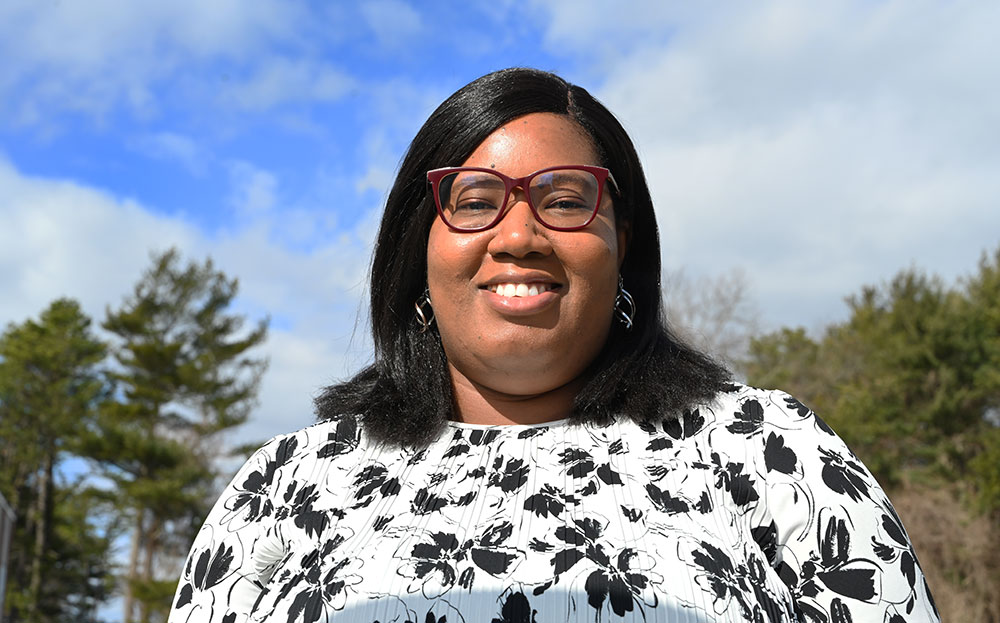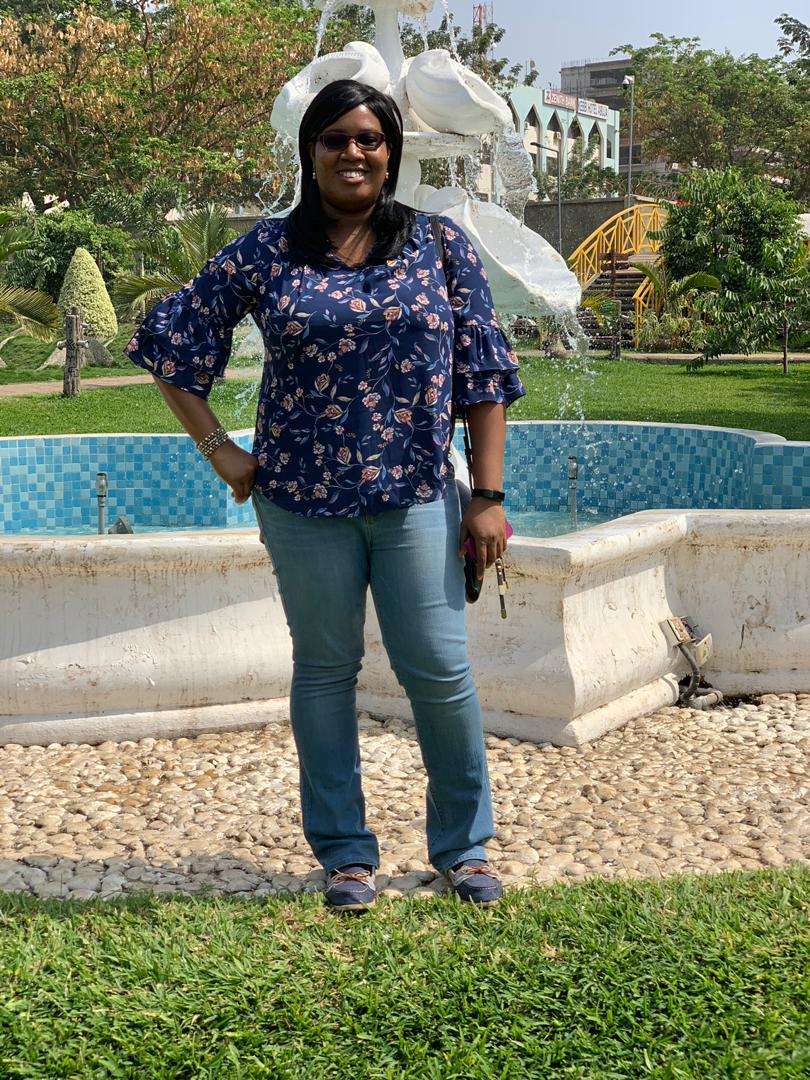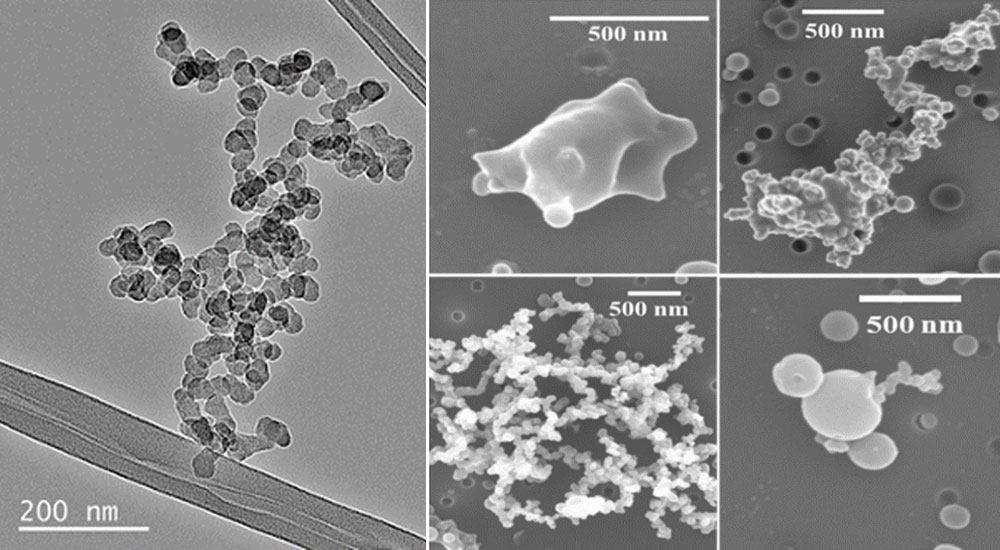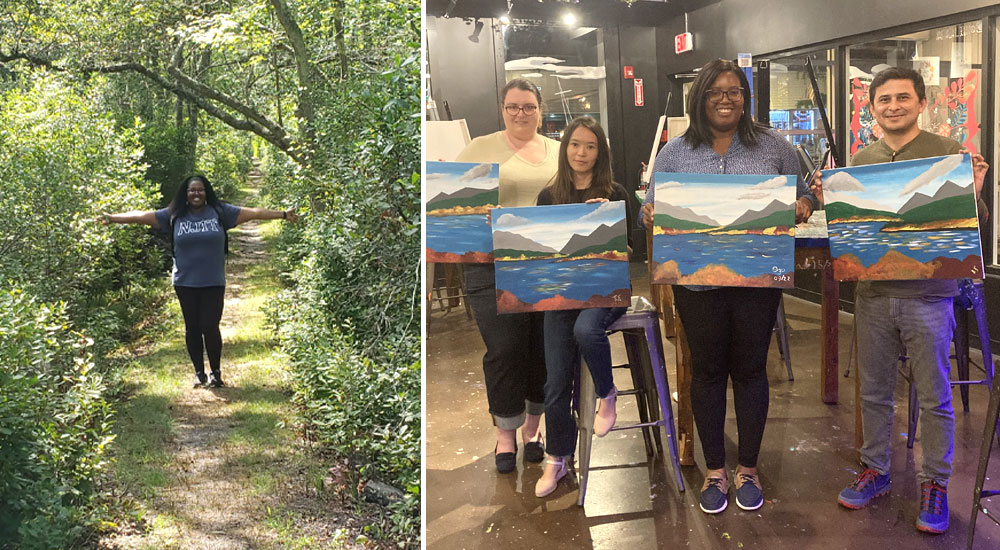This story by Karen McNulty Walsh appeared on the Brookhaven National Laboratory website on March 14, 2023.
For ASR scientist Ogo Enekwizu, simulated cloud studies are building an understanding of how particles emitted in wildfires influence cloud formation and climate

Tiny particles in Earth’s atmosphere can have a big impact on climate. But understanding exactly how these aerosol particles form cloud drops and affect the absorption and scattering of sunlight is one of the biggest sources of uncertainty in climate models. Ogochukwu (Ogo) Enekwizu, a postdoctoral research associate in the Environmental and Climate Sciences Department at the U.S. Department of Energy’s Brookhaven National Laboratory, is trying to tame that complexity.
“Our task is to mimic what happens in the atmosphere by making a cloud in the lab,” she said.
Enekwizu’s research is focused mainly on soot—specifically the black carbon particles emitted by wildfires. Though aerosol particles come from many natural and man-made sources—including dust from deserts, salt from breaking ocean waves, volatile organic compounds from vegetation, volcanic ash, and vehicle exhaust—black carbon is unique because of how much it warms the atmosphere by absorbing sunlight.
“Among all particulate matter aerosols, soot is the strongest global warming agent,” Enekwizu said.
That means wildfires, the biggest source of soot, may be having an increasing impact on Earth’s temperature.
“More warming of Earth’s atmosphere could mean more droughts, more fires, and more light-absorbing aerosol particles,” Enekwizu noted.
“Our goal is to learn how soot particles interact with clouds so we can develop quantifiable relationships that will help us interpret the results from field experiments—including those sampling smoke plumes from real-world wildfires.”
Data from laboratory experiments and real-world studies will ultimately improve how these aerosol-cloud processes are represented in climate models. That, in turn, will help scientists make better predictions about future climate—and potentially develop strategies to prevent our planet from getting stuck in an ever-warming cycle.
Started with a Bang

Enekwizu’s interest in science started with a bang in her middle school chemistry class in Abuja, Nigeria.
“I thought I was going to be an accountant, just like my dad,” she recalled, “until my chemistry teacher showed us a science demo. She placed a tiny pellet of sodium in water and there was a mini explosion. We could see the hydrogen gas being released, bubbling and violent. When we felt the container, it was quite warm. It was fascinating! I was sold on science and never looked back.”
After focusing on science courses in high school, Enekwizu attended Nnamdi Azikiwe University, earning a bachelor’s degree in chemical engineering in 2009. Through those years she became increasingly aware and concerned about the impact of aerosol pollutants in her country.
“My brother attended college in Rivers, the major oil-producing state in Nigeria. Abnormally high levels of soot pollution have plagued residents there for years. The visibility is terrible, and people with asthma, like my brother, struggled to breathe easily,” she said. “As I was studying chemical engineering and learning about the oil industry, I was also hearing a lot about climate change and thought, ‘what else are these pollutants doing to us?’ That’s where my interest in soot began.”
After earning a master’s degree in chemical engineering from the University of Houston, Enekwizu conducted research at the New Jersey Institute of Technology. Her focus was quantifying the direct impacts of soot on climate, which led to her Ph.D. in 2020.
“Now, at Brookhaven [since 2021], I’m expanding my knowledge to also include the indirect climate impacts of soot particles—through their interactions with clouds. In doing so, I’ve come to discover that soot aerosol is just one among many of the players in our unique and complex atmosphere.”
“Being a black female researcher, it is hard to find role models in male-dominated fields of science and engineering. Representation matters, and I hope to be a source of encouragement and inspiration to young girls who have STEM-related aspirations.”
— Ogochukwu Enekwizu
Cloud in a Lab
Bringing a soot-seeded cloud into the lab requires about 10 different scientific instruments. Enekwizu starts with bottles of pure soot—black carbon particles suspended in a solution of high purity water.
“Using an atomizer, we generate tiny water droplets containing the soot particles and then dry them out,” she said.
She then uses a differential mobility analyzer to select particles of a particular size, in the diameter range of 100-250 nanometers (a nanometer is a billionth of a meter). That’s the typical size range for atmospheric soot particles in the vicinity of a wildfire—and about a thousand times smaller than the thickness of a sheet of paper.
Next, she measures the mass of the particles using a centrifugal particle mass analyzer—a “scale” that is sensitive to quadrillionths of a gram (10-15 gram, or a femtogram).
“These particles are very light and fluffy,” Enekwizu said. Under an electron microscope they look like tiny tree branches (or fractals) made of pure carbon.
But in nature, these black carbon particles don’t stay pure for long. Within the first hour of being emitted from a wildfire, all sorts of organic chemicals, vaporized from the burning vegetation, start to glom onto the particle. The organic compounds fill in the voids, encapsulating the branching soot particles in a thick coating. Those organic coatings are what makes it possible for soot particles to form clouds.
“Pure soot particles are notoriously difficult to create cloud droplets,” Enekwizu said. “But the coatings change everything about how the particles interact with water—and with light.”
To learn about those impacts, Enekwizu sends her laboratory-generated soot particles through a “coating chamber.” This instrument generates organic vapors that coat the soot particles, mimicking what happens in wildfires. Then she studies how the coatings—both what they’re made of and how thick they are—affect the particles’ ability to form clouds.
“We send the coated particles into a mini cloud chamber called a cloud condensation nuclei counter. Because of the high level of humidity in the cloud chamber, water condenses onto the aerosol particles until they become cloud droplets. We can track how many particles become cloud droplets,” she explained.
“The mini cloud chamber uses up a lot of water!” she noted, emphasizing that these are still tiny, tiny cloud droplets. “This is like the pre-Kindergarten of cloud mimicry,” she said. In nature, a cloud consists of many tiny cloud droplets.

Ultimate impacts
Enekwizu’s research will help scientists understand how recent findings from field studies affect the formation of clouds, and it will improve scientists’ understanding of how particles from forest fires influence the absorption and scattering of sunlight and heat in Earth’s atmosphere.
For example, a recent study by another team at Brookhaven found that the coatings surrounding soot particles change drastically over the course of the particles’ lifetimes. The findings revealed that soot particles spend most of their lifetime with significantly less coating than the near-fire particles currently used to make predictions in climate models.
That means the models may be missing key impacts. How does a thinner coating affect the chance of a black-carbon particle forming a cloud droplet? Do thinner coatings lead to less scattering and more warming than the models predict?
“I’m exploring a variety of atmospherically relevant coatings to cover the range of impacts of coating properties on the ability of soot particles to form cloud droplets,” Enekwizu said. “Using the tools in my lab, I can also investigate the role of cloud processing on the loss of those coatings and the resulting implications for the optical properties of the soot particles—their ability to scatter and absorb light.”
On the road to answering these questions, Enekwizu also enjoys painting and hiking, and getting away from soot. “It’s nice to be in nature and get fresh air,” she said.
But she doesn’t stay away from her passion for science for long. “At some random times, when I’m staring up at the clouds or even when I’m cooking, I sometimes think of my science—ways I can modify my experiments, an idea I can pursue, or some variable I can tweak.”
She also volunteers to judge science contests and often speaks to students.
“I enjoy mentoring students and still follow up on those I trained while in grad school,” she said. “Being a black female researcher, it is hard to find role models in male-dominated fields of science and engineering. Representation matters, and I hope to be a source of encouragement and inspiration to young girls who have STEM-related aspirations,” she said.
Enekwizu’s research is supported by the DOE Office of Science (BER).

Read the original version of this story on the Brookhaven National Laboratory website.
# # #Author: Karen McNulty Walsh, Brookhaven National Laboratory
This work was supported by the U.S. Department of Energy’s Office of Science, through the Biological and Environmental Research program as part of the Atmospheric System Research program.

